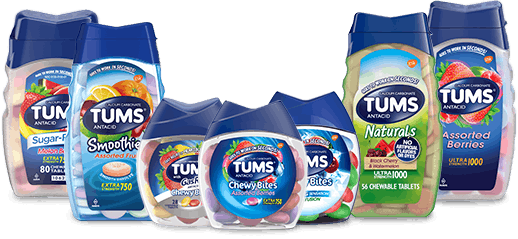Upset Stomach After Eating?
Find Out What’s Happening in Your Body
How to Avoid an Upset Stomach
You’ve just enjoyed a delicious meal and are clearing the dishes from the table when it starts—an upset stomach. Getting an upset stomach after eating is something that most of us have experienced at one time or another—and when it happens, it can be debilitating. So why do we experience stomach discomfort after eating? And how can we get rid of the uncomfortable symptoms? Read on to learn more about what’s happening to your body and how to get relief.
Causes of Upset Stomach
Are you looking for relief for stomach discomfort? Determining the cause of your upset stomach is a good place to start. Commonly referred to as “indigestion,” an upset stomach can be caused by the following factors:
- Eating too quickly or too much
- Eating spicy, fatty, or greasy foods
- Eating acidic foods
- Drinking too many carbonated beverages
- Overdoing it on caffeine
- Drinking too much alcohol1
If you’re experiencing an upset stomach after eating, take a second to think about whether or not one of these behaviors applies to you. Did you just eat a few too many slices of greasy pizza a little too fast? This may cause indigestion or upset stomach.
Symptoms of Upset Stomach
Signs of indigestion can vary from individual to individual. Sometimes, indigestion makes you feel full too soon while eating a meal, or you may feel uncomfortably full after eating a meal.1 Other symptoms include:
- Pain in the upper abdomen
- Burning in the upper abdomen
- Bloating
- Burping
- Nausea
- Gas
- Heartburn1
Indigestion and heartburn are often confused, but they’re actually not the same thing. You may experience heartburn if you have indigestion, but they are two separate conditions, and you can have indigestion with no heartburn symptoms at all.1 Explore more information about heartburn.
How to Relieve Upset Stomach
It’s hard to ignore an upset stomach, especially if it happens often. Depending on the cause of your discomfort, there are a few ways you can get rid of an upset stomach during or after eating:
- Drink clear, cold fluids
- Eat your meals slowly
- Drink beverages slowly
- Eat smaller, more frequent meals
- Limit or avoid fried, greasy or sweet foods
- Avoid activity after eating
- Try over-the-counter medications if you’re experiencing heartburn1,2
You may be sensitive to certain foods. One suggestion is to keep a food diary, track your food intake, and record when and how you experience indigestion symptoms. We’ve listed some common trigger foods in the next section for your reference.
If your symptoms are severe or frequent, there may be a chance you have an underlying digestive health condition. Talk to your doctor as soon as possible if you’re concerned about your digestive health.
Foods That Can Trigger Stomach Upset
As noted above, certain types of food and drink are often to blame for an upset stomach after eating, whether it’s pain due to indigestion or heartburn. While it might be a bummer to find out that some of your favorite mealtime choices are the cause of your discomfort, ultimately making changes in your diet can help give you some much-needed relief.
Here are some foods that commonly cause indigestion:
Spicy food
Put down the Sriracha and lay off the jalapeño poppers—spicy food is one popular cause of stomach discomfort.3 If you love spicy food but your stomach doesn’t, try to consume it only occasionally and in limited quantities to see if you notice an improvement. If you can’t handle spicy food at all, don’t worry! Stock up on seasonings like black pepper, sweet paprika, oregano, cumin, dried basil, garlic powder, and onion powder to give your food some flavor.
Tomato products
One of the most notorious trigger foods of heartburn and indigestion alike, tomatoes and tomato based products may be causing your upset stomach.3 Ketchup, marinara sauce, tomato paste, and tomato soup all make the list of tomato products to avoid.
Fatty, fried foods
Mozzarella sticks, deep-fried eggrolls, funnel cake, churros, fried chicken, falafel, hash browns— almost every cuisine has a fried specialty that may taste great but ultimately makes your gut feel less-than-great.3
Alcoholic beverages
Whether it was a few too many glasses of wine or that last-call cocktail you know you didn’t need, alcohol can trigger stomach discomfort.3 Reduce your alcohol consumption or talk to your doctor if you think alcoholic drinks may be the cause of your upset stomach
Foods That Keep Your Digestive System Healthy
Just like there are foods that may trigger stomach upset, there are also plenty of healthy, wholefood options that support digestive health and help keep your digestive system running smoothly. Eating a healthy, well-balanced diet can help support your digestion.1 That being said, if your indigestion is due to an underlying condition or disease, additional treatment may be needed. Reach out to your doctor if you suspect you have a digestive health condition, such as GERD.
Eating a nutritious, well-rounded diet, rich in vitamins and minerals can help promote digestive health. Here are some ideas for foods that can help your stomach feel its best:
Fruit
Fruit, including fruit that is fresh, canned, frozen, and dried, is part of a balanced diet.4 Try fresh apples, grapes, peaches, pears, watermelon and bananas, and dried fruit like raisins and prunes.
Dark green vegetables
Leafy greens like collard greens, mustard greens, turnip greens, and kale, in addition to broccoli, spinach, and watercress, are included in the dark green vegetable category, which is part of a healthy, balanced diet.5 Steam your greens, add them to a smoothie, or try them in a salad for gut-friendly options.
Whole grains
Getting your requisite daily amount of grains, especially whole grains, is another essential part of a healthy diet. Some delicious choices for whole grains include oatmeal, bulger, whole cornmeal, brown rice, and breads made with whole-wheat flour. The USDA recommends making sure at least half of your daily grain intake is in whole grains.6
We hope this article has given you some helpful tips on avoiding an upset stomach after eating.
SOURCES
- Symptoms & Causes of Indigestion. National Institute of Diabetes and Digestive and Kidney Diseases. https://www.niddk.nih.gov/health-information/digestive-diseases/indigestiondyspepsia/symptoms-causes. Accessed 2/8/2021.
- Nausea & Vomiting: Care and Treatment. Cleveland Clinic. https://my.clevelandclinic.org/health/symptoms/8106-nausea--vomiting/care-and-treatment. Accessed 2/8/2021.
- Heartburn. Mayo Clinic. https://www.mayoclinic.org/diseases-conditions/heartburn/symptomscauses/syc-20373223. Accessed 10/15/20.
- All About the Fruit Group. USDA ChooseMyPlate. https://www.choosemyplate.gov/eathealthy/fruits. Accessed 10/15/20.
- All about the Vegetable Group. USDA ChooseMyPlate. https://www.choosemyplate.gov/eathealthy/vegetables. Accessed 10/15/20.
- All about the Grains Group. USDA ChooseMyPlate. https://www.choosemyplate.gov/eathealthy/grains. Accessed 10/15/20.


